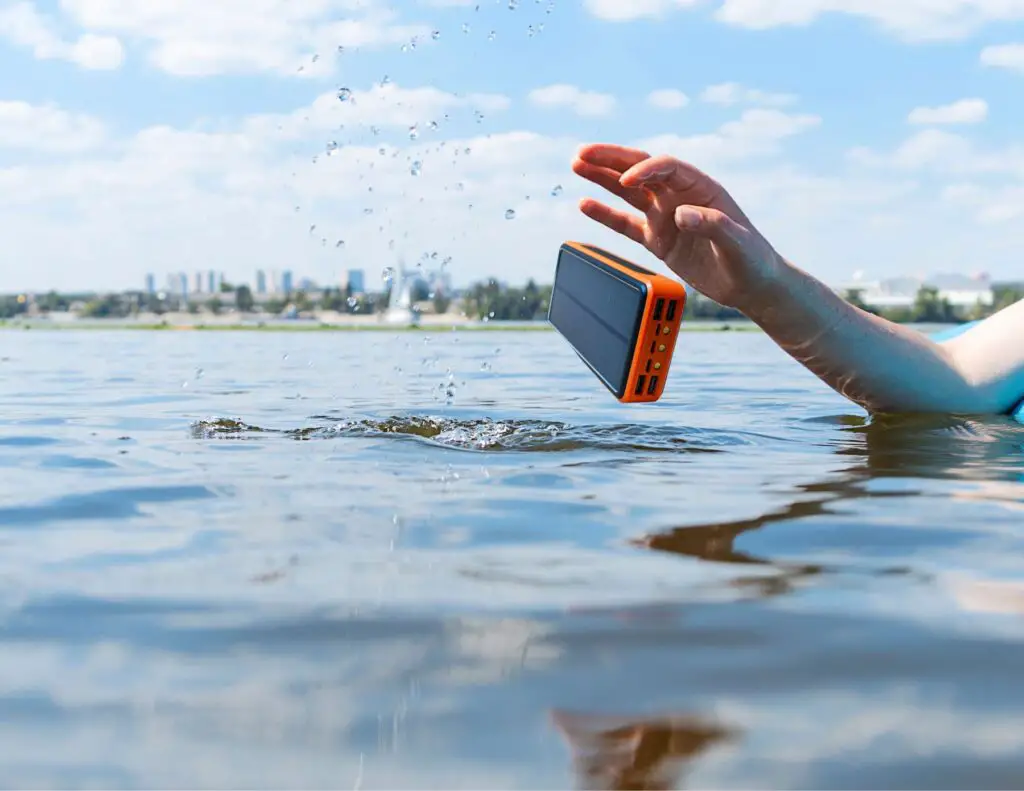
Solar power banks are becoming increasingly popular as people look for ways to charge their devices on the go. These portable chargers are powered by solar panels, making them a great option for outdoor activities and traveling. However, some people may be unsure of how to properly charge a solar power bank, which can lead to frustration and a dead battery when it’s needed most.
To charge a solar power bank the most obvious is to leave it in the sun to charge using the built-in solar panels. However, this can take several hours or even days depending on the strength of the sun and the capacity of the battery.
Alternatively, the solar power bank can be charged using a USB cable connected to a power source, such as a laptop or wall adapter. This method is faster but requires access to electricity.
Charging a Solar Power Bank
When it comes to charging a solar power bank, there are a few things to consider. In this section, I will cover the charging time, charging methods, and charging capacity of a solar power bank.
Charging Time
The charging time of a solar power bank can vary depending on the amount of sunlight it receives and the capacity of the power bank.
In general, it can take anywhere from 8 to 12 hours to fully charge a solar power bank using solar energy alone. However, if you are in a hurry, you can also charge it using a wall outlet or USB cable.
Charging Methods
There are three main ways to charge a solar power bank:
- Using Solar Energy
- A Wall Outlet
- USB Cable
Solar Energy
To charge a solar power bank using solar energy, you need to place the solar charger in direct sunlight. It is important to note that the charging rate will depend on the strength of the sunlight and the temperature. The hotter the temperature, the slower the charging rate.
Wall Outlet
If you need to charge your solar power bank quickly, you can use a wall outlet. Simply plug in the USB cable that came with your solar power bank into the wall adapter and connect it to your power bank.
USB Cable
Another way to charge a solar power bank is by using a USB cable. This is a convenient option if you have access to a computer or a power bank that has a USB port.
Charging Capacity
The charging capacity of a solar power bank refers to the amount of energy it can store and the amount of devices it can charge.
Solar power banks come in different capacities, ranging from 5,000mAh to 20,000mAh or more. The higher the capacity, the more devices you can charge and the longer the power bank will last.
Charging a solar power bank can be done using solar energy, a wall outlet, or a USB cable. The charging time can vary depending on the method used, the amount of sunlight available, and the temperature. It is important to choose a solar power bank with a capacity that meets your needs.
Understanding Solar Power Banks
What are Solar Power Banks?
Solar power banks are portable electronic devices that store energy from the sun in an internal battery. They are designed to charge other electronic devices such as smartphones, tablets, and cameras. Solar power banks are an eco-friendly and convenient way to charge your devices while on the go.
How do Solar Power Banks Work?
Solar power banks work by converting sunlight into electricity through the use of solar panels. The solar panels are made up of photovoltaic cells that absorb sunlight and convert it into direct current (DC) electricity. This DC electricity is then stored in the internal battery of the solar power bank.
When you connect your electronic device to the solar power bank, the stored electricity is converted into alternating current (AC) electricity and transferred to your device through the charging port.
Different Types of Solar Power Banks
There are several different types of solar power banks available on the market. The most common types include:
- Folding Solar Power Banks: These solar power banks feature solar panels that fold up for easy storage and portability. They are ideal for outdoor activities such as camping and hiking.
- Waterproof Solar Power Banks: These solar power banks are designed to be waterproof, making them perfect for use in wet environments such as the beach or pool.
- High Capacity Solar Power Banks: These solar power banks have a larger battery capacity and are capable of charging multiple electronic devices at once.
Remember, solar power banks require direct sunlight to charge efficiently. Charging times may vary depending on the capacity of the solar power bank and the amount of sunlight available.
Solar power banks are a great way to charge your electronic devices while on the go. They are eco-friendly, portable, and convenient.

I’ve put together this comprehensive buyers guide if you’re thinking of getting a Solar Power Bank for your Next Outdoor Adventure!
Using a Solar Power Bank
Solar power banks are a great way to charge your devices while on the go, especially when you’re in a remote location without access to electrical energy. Here are some tips on how to use a solar power bank effectively:
Charging Devices
The first thing to consider when using a solar power bank is what devices you want to charge. Most solar power banks come with USB ports, which means you can charge any mobile device that uses a USB charger. Some solar power banks also come with built-in cables, which can be helpful if you don’t want to carry around extra cables.
Charging Simultaneously
Another important consideration is whether you can charge multiple devices at the same time. Some solar power banks have multiple USB ports, which means you can charge multiple devices simultaneously. However, keep in mind that charging multiple devices at the same time may reduce the charging speed.
Charging Capacity
The charging capacity of a solar power bank is the amount of electrical energy it can store. The higher the charging capacity, the more devices you can charge before the power bank needs to be recharged. However, keep in mind that higher charging capacity also means a larger and heavier power bank.
Power Output
The power output of a solar power bank is the amount of electrical energy it can provide to your devices. This is usually measured in watts. The higher the power output, the faster your devices will charge. However, keep in mind that higher power output also means a larger and more expensive power bank.
When using a solar power bank, it’s important to avoid overcharging and discharging. Overcharging can reduce the battery life of your power bank, while discharging can reduce the lifespan of your mobile devices. It’s also important to keep your solar power bank away from shade and dust, as these can reduce its charging capabilities.
Solar power banks are great for outdoor activities such as camping, hiking, and cycling. However, keep in mind that their charging capabilities may be reduced on cloudy days. It’s also important to avoid overcharging your power bank, as this can damage the battery and reduce its lifespan.
A solar power bank is a great way to charge your mobile devices while on the go. Just make sure to choose a power bank with the right charging capacity and power output for your needs, and avoid overcharging and discharging.
FAQs About Charging a Solar Power Bank
Can I Charge a Solar Power Bank Using a Wall Outlet?
Most solar power banks come with a built-in charging port that allows you to charge them using a wall outlet. This is especially useful when you have limited sunlight or need to charge a solar power bank quickly.
What Can Affect the Charging Efficiency of A Solar Power Bank?
Factors that can impact the charging efficiency of a solar power bank include the angle and position of the solar panels towards the sun, the weather conditions (cloudy or sunny), and any obstructions that might block the sunlight.
Can I Charge a Solar Power Bank Indoors?
While solar power banks are primarily designed to be charged using sunlight, some models also offer the option to charge them through a USB connection or a wall outlet. This allows you to charge a solar power bank indoors or in situations where sunlight is limited.
How Can I Maximize the Charging Efficiency of My Solar Power Bank?
To maximize the charging efficiency of your solar power bank, ensure that the solar panels are exposed to direct sunlight without any obstructions. Keep the panels clean and free from dust or debris that could hinder their performance. Additionally, adjusting the angle of the solar panels to face the sun directly can enhance charging efficiency.
Can I Charge Electronic Devices Directly from A Solar Power Bank?
Typically, solar power banks are designed to charge electronic devices directly. Simply connect your device to the power bank using a compatible charging cable, and the stored energy in the power bank will transfer to your device.
How Many Devices Can I Charge with A Solar Power Bank?
The number of devices you can charge depends on the capacity of your solar power bank and the energy requirements of the devices you are charging. Higher capacity power banks can charge multiple devices simultaneously, while smaller capacity ones may only be able to charge one device at a time.

Are Solar Power Banks Waterproof?
Not all solar power banks are waterproof, so it is important to check the specifications of the specific model you are considering.
Some power banks are designed to be water-resistant, making them suitable for outdoor use or during light rain showers, while others may not be water-resistant at all.
Can I Leave My Solar Power Bank Charging in The Sun Indefinitely?
While solar power banks are designed to handle sunlight exposure, it is not recommended to leave them charging in the sun indefinitely. Overcharging can potentially damage the battery or reduce its overall lifespan. It is advisable to monitor the charging progress and disconnect the power bank once it is fully charged.
Final Thoughts
Learning how to charge a solar power bank is a simple and convenient process that can be done almost anywhere with access to sunlight. By following the manufacturer’s instructions and taking a few precautions, users can ensure that their power bank is charged safely and efficiently.
It is important to note that not all solar power banks are created equal. Users should carefully research and select a power bank from a reputable manufacturer that meets their specific needs and requirements. Some manufacturers offer power banks with larger battery capacities, faster charging times, and additional features such as built-in flashlights and waterproof casings.
When charging a solar power bank, it is important to place it in direct sunlight and avoid shading the solar panels. Users should also monitor the charging progress and remove the power bank from the sun once it is fully charged to prevent overcharging and potential damage to the battery.
Overall, a solar power bank is a valuable and eco-friendly tool for anyone who needs to charge their devices on the go!
